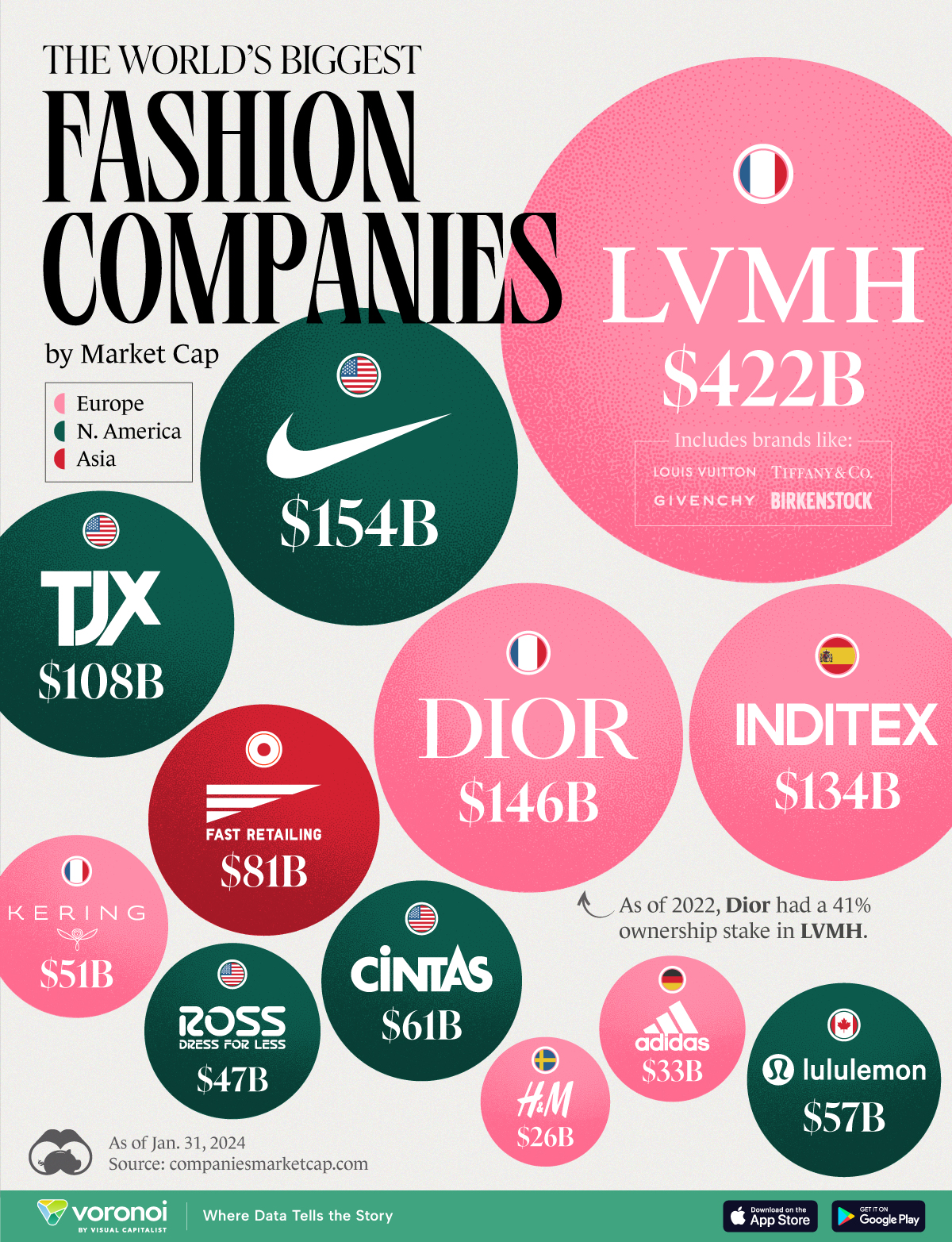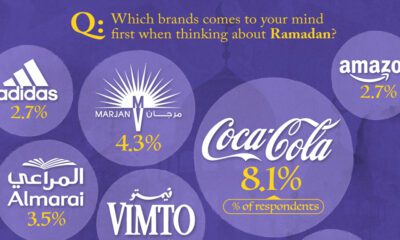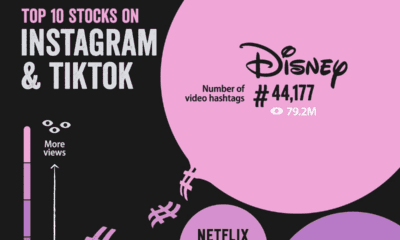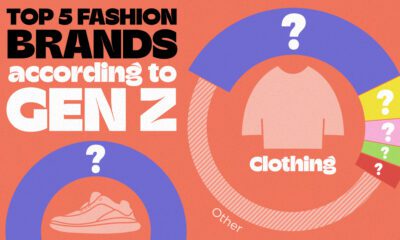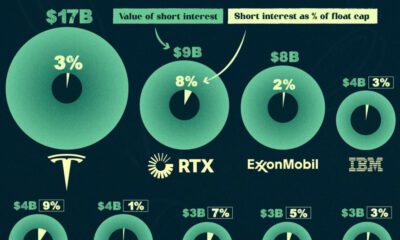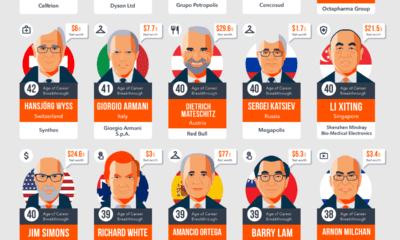Markets
The World’s Biggest Fashion Companies by Market Cap
![]() See this visualization first on the Voronoi app.
See this visualization first on the Voronoi app.
The World’s Biggest Fashion Companies by Market Cap
This was originally posted on our Voronoi app. Download the app for free on iOS or Android and discover incredible data-driven charts from a variety of trusted sources.
Fashion is one of the largest industries globally, accounting for 2% of the global gross domestic product (GDP).
In this graphic, we use data from CompaniesMarketCap to showcase the world’s 12 largest publicly traded fashion companies, ranked by market capitalization as of Jan. 31, 2024.
LVMH Reigns Supreme
European countries dominate the list of the biggest fashion companies, with six in total. The U.S. boasts four companies, while Japan and Canada each have one.
LVMH Moët Hennessy Louis Vuitton (LVMH) is the industry’s biggest player by a wide margin. The company boasts an extensive portfolio of luxury brands spanning fashion, cosmetics, and liquor, including Marc Jacobs, Givenchy, Fendi, and Dior, the latter of which holds a 41% ownership stake in the global luxury goods company.
| Rank | Country | Name | Market Cap (USD) |
|---|---|---|---|
| 1 | 🇫🇷 France | LVMH | 421,600,000,000 |
| 2 | 🇺🇸 United States | Nike | 153,830,000,000 |
| 3 | 🇫🇷 France | Dior | 145,861,000,000 |
| 4 | 🇪🇸 Spain | Inditex | 134,042,000,000 |
| 5 | 🇺🇸 United States | TJX Companies | 108,167,000,000 |
| 6 | 🇯🇵 Japan | Fast Retailing | 81,489,917,976 |
| 7 | 🇺🇸 United States | Cintas | 61,285,867,520 |
| 8 | 🇨🇦 Canada | lululemon | 57,267,998,720 |
| 9 | 🇫🇷 France | Kering | 50,900,207,000 |
| 10 | 🇺🇸 United States | Ross Stores | 47,227,502,592 |
| 11 | 🇩🇪 Germany | Adidas | 32,535,078,209 |
| 12 | 🇸🇪 Sweden | H&M | 25,564,163,571 |
As a result of the success of the company, in 2024, LVMH chairman Bernard Arnault overtook Elon Musk as the richest person in the world.
In second place, Nike generated 68% of its revenue in 2023 from footwear. One of the company’s most popular brands, the Jordan Brand, generates around $5 billion in revenue per year.
The list also includes less-known names like Inditex, a corporate entity that owns Zara, as well as several other brands, and Fast Retailing, a Japanese holding company that owns Uniqlo, Theory, and Helmut Lang.
According to McKinsey & Company, the fashion industry is expected to experience modest growth of 2% to 4% in 2024, compared to 5% to 7% in 2023, attributed to subdued economic growth and weakened consumer confidence. The luxury segment is projected to contribute the largest share of economic profit.
Markets
U.S. Debt Interest Payments Reach $1 Trillion
U.S. debt interest payments have surged past the $1 trillion dollar mark, amid high interest rates and an ever-expanding debt burden.

U.S. Debt Interest Payments Reach $1 Trillion
This was originally posted on our Voronoi app. Download the app for free on iOS or Android and discover incredible data-driven charts from a variety of trusted sources.
The cost of paying for America’s national debt crossed the $1 trillion dollar mark in 2023, driven by high interest rates and a record $34 trillion mountain of debt.
Over the last decade, U.S. debt interest payments have more than doubled amid vast government spending during the pandemic crisis. As debt payments continue to soar, the Congressional Budget Office (CBO) reported that debt servicing costs surpassed defense spending for the first time ever this year.
This graphic shows the sharp rise in U.S. debt payments, based on data from the Federal Reserve.
A $1 Trillion Interest Bill, and Growing
Below, we show how U.S. debt interest payments have risen at a faster pace than at another time in modern history:
| Date | Interest Payments | U.S. National Debt |
|---|---|---|
| 2023 | $1.0T | $34.0T |
| 2022 | $830B | $31.4T |
| 2021 | $612B | $29.6T |
| 2020 | $518B | $27.7T |
| 2019 | $564B | $23.2T |
| 2018 | $571B | $22.0T |
| 2017 | $493B | $20.5T |
| 2016 | $460B | $20.0T |
| 2015 | $435B | $18.9T |
| 2014 | $442B | $18.1T |
| 2013 | $425B | $17.2T |
| 2012 | $417B | $16.4T |
| 2011 | $433B | $15.2T |
| 2010 | $400B | $14.0T |
| 2009 | $354B | $12.3T |
| 2008 | $380B | $10.7T |
| 2007 | $414B | $9.2T |
| 2006 | $387B | $8.7T |
| 2005 | $355B | $8.2T |
| 2004 | $318B | $7.6T |
| 2003 | $294B | $7.0T |
| 2002 | $298B | $6.4T |
| 2001 | $318B | $5.9T |
| 2000 | $353B | $5.7T |
| 1999 | $353B | $5.8T |
| 1998 | $360B | $5.6T |
| 1997 | $368B | $5.5T |
| 1996 | $362B | $5.3T |
| 1995 | $357B | $5.0T |
| 1994 | $334B | $4.8T |
| 1993 | $311B | $4.5T |
| 1992 | $306B | $4.2T |
| 1991 | $308B | $3.8T |
| 1990 | $298B | $3.4T |
| 1989 | $275B | $3.0T |
| 1988 | $254B | $2.7T |
| 1987 | $240B | $2.4T |
| 1986 | $225B | $2.2T |
| 1985 | $219B | $1.9T |
| 1984 | $205B | $1.7T |
| 1983 | $176B | $1.4T |
| 1982 | $157B | $1.2T |
| 1981 | $142B | $1.0T |
| 1980 | $113B | $930.2B |
| 1979 | $96B | $845.1B |
| 1978 | $84B | $789.2B |
| 1977 | $69B | $718.9B |
| 1976 | $61B | $653.5B |
| 1975 | $55B | $576.6B |
| 1974 | $50B | $492.7B |
| 1973 | $45B | $469.1B |
| 1972 | $39B | $448.5B |
| 1971 | $36B | $424.1B |
| 1970 | $35B | $389.2B |
| 1969 | $30B | $368.2B |
| 1968 | $25B | $358.0B |
| 1967 | $23B | $344.7B |
| 1966 | $21B | $329.3B |
Interest payments represent seasonally adjusted annual rate at the end of Q4.
At current rates, the U.S. national debt is growing by a remarkable $1 trillion about every 100 days, equal to roughly $3.6 trillion per year.
As the national debt has ballooned, debt payments even exceeded Medicaid outlays in 2023—one of the government’s largest expenditures. On average, the U.S. spent more than $2 billion per day on interest costs last year. Going further, the U.S. government is projected to spend a historic $12.4 trillion on interest payments over the next decade, averaging about $37,100 per American.
Exacerbating matters is that the U.S. is running a steep deficit, which stood at $1.1 trillion for the first six months of fiscal 2024. This has accelerated due to the 43% increase in debt servicing costs along with a $31 billion dollar increase in defense spending from a year earlier. Additionally, a $30 billion increase in funding for the Federal Deposit Insurance Corporation in light of the regional banking crisis last year was a major contributor to the deficit increase.
Overall, the CBO forecasts that roughly 75% of the federal deficit’s increase will be due to interest costs by 2034.
-

 Real Estate2 weeks ago
Real Estate2 weeks agoVisualizing America’s Shortage of Affordable Homes
-

 Technology1 week ago
Technology1 week agoRanked: Semiconductor Companies by Industry Revenue Share
-

 Money1 week ago
Money1 week agoWhich States Have the Highest Minimum Wage in America?
-

 Real Estate1 week ago
Real Estate1 week agoRanked: The Most Valuable Housing Markets in America
-

 Business1 week ago
Business1 week agoCharted: Big Four Market Share by S&P 500 Audits
-

 AI1 week ago
AI1 week agoThe Stock Performance of U.S. Chipmakers So Far in 2024
-

 Misc2 weeks ago
Misc2 weeks agoAlmost Every EV Stock is Down After Q1 2024
-

 Money2 weeks ago
Money2 weeks agoWhere Does One U.S. Tax Dollar Go?

